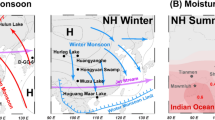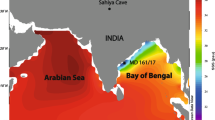Abstract
The North Atlantic Oscillation is the dominant atmospheric pressure mode in the North Atlantic region and affects winter temperature and precipitation in the Mediterranean, northwest Europe, Greenland, and Asia1. The index1 that describes the sea-level pressure difference between Iceland and the Azores is correlated with a dipole precipitation pattern over northwest Europe and northwest Africa. How the North Atlantic Oscillation will develop as the Greenland ice sheet melts is unclear2. A potential past analogue is the early Holocene, during which melting ice sheets around the North Atlantic3,4 freshened surface waters, affecting the strength of the meridional overturning circulation5. Here we present a Holocene rainfall record from northwest Africa based on speleothem δ18O and compare it against a speleothem-based rainfall record from Europe6. The two records are positively correlated during the early Holocene, followed by a shift to an anti-correlation, similar to the modern record, during the mid-Holocene. On the basis of our simulations with an Earth system model, we suggest the shift to the anti-correlation reflects a large-scale atmospheric and oceanic reorganization in response to the demise of the Laurentide ice sheet and a strong reduction of meltwater flux to the North Atlantic, pointing to a potential sensitivity of the North Atlantic Oscillation to the melting of ice sheets.
This is a preview of subscription content, access via your institution
Access options
Subscribe to this journal
Receive 12 print issues and online access
$259.00 per year
only $21.58 per issue
Buy this article
- Purchase on Springer Link
- Instant access to full article PDF
Prices may be subject to local taxes which are calculated during checkout



Similar content being viewed by others
References
Hurrell, J. W. Decadal trends in the North-Atlantic Oscillation—regional temperatures and precipitation. Science 269, 676–679 (1995).
IPCC Climate Change 2013: The Physical Science Basis (eds Stocker, T. F. et al.) (Cambridge Univ. Press, 2013).
Carlson, A. E. et al. Rapid early Holocene deglaciation of the Laurentide ice sheet. Nature Geosci. 1, 620–624 (2008).
Peltier, W. R. Global glacial isostasy and the surface of the ice-age Earth: the ICE-5G (VM2) model and GRACE. Annu. Rev. Earth Planet. Sci. 32, 111–149 (2004).
LeGrande, A. N. et al. Consistent simulation of multiple proxy responses to an abrupt climate change event. Proc. Natl Acad. Sci. USA 103, 837–842 (2006).
Fohlmeister, J. et al. Bunker Cave stalagmites: an archive for central European Holocene climate variability. Clim. Past 8, 1751–1764 (2012).
Vicente Serrano, S. M. & Trigo, R. M. Hydrological, Socioeconomic and Ecological Impacts of the North Atlantic Oscillation in the Mediterranean Region Vol. 46 (Advances in Global Change Research, Springer, 2011).
Trouet, V. et al. Persistent positive North Atlantic Oscillation mode dominated the Medieval Climate Anomaly. Science 324, 78–80 (2009).
Olsen, J., Anderson, J. N. & Knudsen, M. F. Variability of the North Atlantic Oscillation over the past 5,200 years. Nature Geosci. 5, 808–812 (2012).
Dong, B. W., Sutton, R. T. & Woollings, T. Changes of interannual NAO variability in response to greenhouse gases forcing. Clim. Dynam. 37, 1621–1641 (2011).
Wang, Y. H., Magnusdottir, G., Stern, H., Tian, X. & Yu, Y. Decadal variability of the NAO: introducing an augmented NAO index. Geophys. Res. Lett. 39, L21702 (2012).
Ortega, P. et al. A model-tested North Atlantic Oscillation reconstruction for the past millennium. Nature 523, 71–74 (2015).
Rimbu, N., Lohmann, G., Lorenz, S. J., Kim, J. H. & Schneider, R. R. Holocene climate variability as derived from alkenone sea surface temperature and coupled ocean–atmosphere model experiments. Clim. Dynam. 23, 215–227 (2004).
Wassenburg, J. A. et al. Climate and cave control on Pleistocene/Holocene calcite-to-aragonite transitions in speleothems from Morocco: elemental and isotopic evidence. Geochim. Cosmochim. Acta 92, 23–47 (2012).
deMenocal, P. et al. Abrupt onset and termination of the African Humid Period: rapid climate responses to gradual insolation forcing. Quat. Sci. Rev. 19, 347–361 (2000).
Jungclaus, J. H. et al. Climate and carbon-cycle variability over the last millennium. Clim. Past 6, 723–737 (2010).
Wei, W. & Lohmann, G. Simulated Atlantic multidecadal oscillation during the Holocene. J. Clim. 25, 6989–7002 (2012).
Czaja, A. & Frankignoul, C. Influence of the North Atlantic SST on the atmospheric circulation. Geophys. Res. Lett. 26, 2969–2972 (1999).
Deser, C., Alexander, M. A., Xie, S. P. & Phillips, A. S. Sea surface temperature variability: patterns and mechanisms. Annu. Rev. Mar. Sci. 2, 115–143 (2010).
Delworth, T. L. & Mann, M. E. Observed and simulated multidecadal variability in the Northern Hemisphere. Clim. Dynam. 16, 661–676 (2000).
Knudsen, M. F., Seidenkrantz, M. S., Jacobsen, B. H. & Kuijpers, A. Tracking the Atlantic Multidecadal Oscillation through the last 8,000 years. Nature Commun. 2, 178 (2011).
Oglesby, R., Feng, S., Hu, Q. & Rowe, C. The role of the Atlantic Multidecadal Oscillation on medieval drought in North America: synthesizing results from proxy data and climate models. Glob. Planet. Change 84–85, 56–65 (2012).
Jones, P. D., Jonsson, T. & Wheeler, D. Extension to the North Atlantic Oscillation using early instrumental pressure observations from Gibraltar and south-west Iceland. Int. J. Climatol. 17, 1433–1450 (1997).
Harris, I., Jones, P. D., Osborn, T. J. & Lister, D. H. Updated high-resolution grids of monthly climatic observations—the CRU TS3.10 Dataset. Int. J. Climatol. 34, 623–643 (2014).
Wassenburg, J. A. et al. Moroccan speleothem and tree ring records suggest a variable positive state of the North Atlantic Oscillation during the Medieval Warm Period. Earth Planet. Sci. Lett. 375, 291–302 (2013).
Proctor, C. J., Baker, A. & Barnes, W. L. A three thousand year record of North Atlantic climate. Clim. Dynam. 19, 449–454 (2002).
Drysdale, R. et al. Late Holocene drought responsible for the collapse of Old World civilizations is recorded in an Italian cave flowstone. Geology 34, 101–104 (2006).
Laskar, J. et al. A long-term numerical solution for the insolation quantities of the Earth. Astron. Astrophys. 428, 261–285 (2004).
Kim, S. T., O’Neil, J. R., Hillaire-Marcel, C. & Mucci, A. Oxygen isotope fractionation between synthetic aragonite and water: influence of temperature and Mg2+ concentration. Geochim. Cosmochim. Acta 71, 4704–4715 (2007).
Romanek, C. S., Grossman, E. L. & Morse, J. W. Carbon isotope fractionation in synthetic aragonite and calcite—effects of temperature and precipitation rate. Geochim. Cosmochim. Acta 56, 419–430 (1992).
Finch, A. A., Shaw, P. A., Holmgren, K. & Lee-Thorp, J. Corroborated rainfall records from aragonitic stalagmites. Earth Planet. Sci. Lett. 215, 265–273 (2003).
McMillan, E. A., Fairchild, I. J., Frisia, S., Borsato, A. & McDermott, F. Annual trace element cycles in calcite–aragonite speleothems: evidence of drought in the western Mediterranean 1200–1100 yr BP . J. Quat. Sci. 20, 423–433 (2005).
Jochum, K. P., Stoll, B., Herwig, K. & Willbold, M. Validation of LA-ICP-MS trace element analysis of geological glasses using a new solid-state 193 nm Nd:YAG laser and matrix-matched calibration. J. Anal. At. Spectrom. 22, 112–121 (2007).
Jochum, K. P. et al. Determination of reference values for NIST SRM 610–617 glasses following ISO guidelines. Geostand. Geoanal. Res. 35, 397–429 (2011).
Fietzke, J., Liebetrau, V., Eisenhauer, A. & Dullo, C. Determination of uranium isotope ratios by multi-static MIC-ICP-MS: method and implementation for precise U- and Th-series isotope measurements. J. Anal. At. Spectrom. 20, 395–401 (2005).
Scholz, D. & Hoffmann, D. L. StalAge—an algorithm designed for construction of speleothem age models. Quat. Geochronol. 6, 369–382 (2011).
Fohlmeister, J. A statistical approach to construct composite climate records of dated archives. Quat. Geochronol. 14, 48–56 (2012).
Roeckner, E. et al. The Atmospheric General Circulation Model ECHAM5. Part 1: Model Description Vol. 131 (Max Planck Institute for Meteorology, 2003).
Raddatz, T. J. et al. Will the tropical land biosphere dominate the climate-carbon cycle feedback during the twenty-first century? Clim. Dynam. 29, 565–574 (2007).
Brovkin, V., Raddatz, T., Reick, C. H., Claussen, M. & Gayler, V. Global biogeophysical interactions between forest and climate. Geophys. Res. Lett. 36, L07405 (2009).
Marsland, S. J., Haak, H., Jungclaus, J. H., Latif, M. & Roske, F. The Max-Planck-Institute global ocean/sea ice model with orthogonal curvilinear coordinates. Ocean Model. 5, 91–127 (2003).
Stepanek, C. & Lohmann, G. Modelling mid-Pliocene climate with COSMOS. Geosci. Model Dev. 5, 1221–1243 (2012).
Knorr, G., Butzin, M., Micheels, A. & Lohmann, G. A warm Miocene climate at low atmospheric CO2 levels. Geophys. Res. Lett. 38, L20701 (2011).
Wei, W., Lohmann, G. & Dima, M. Distinct modes of internal variability in the global meridional overturning circulation associated with the Southern Hemisphere westerly winds. J. Phys. Oceanogr. 42, 785–801 (2012).
Berger, A. L. Long-term variations of daily insolation and Quaternary climatic changes. J. Atmos. Sci. 35, 2362–2367 (1978).
Indermuhle, A. et al. Holocene carbon-cycle dynamics based on CO2 trapped in ice at Taylor Dome, Antarctica. Nature 398, 121–126 (1999).
Sowers, T., Alley, R. B. & Jubenville, J. Ice core records of atmospheric N2O covering the last 106,000 years. Science 301, 945–948 (2003).
Brook, E. J., Harder, S., Severinghaus, J., Steig, E. J. & Sucher, C. M. On the origin and timing of rapid changes in atmospheric methane during the last glacial period. Glob. Biogeochem. Cycles 14, 559–572 (2000).
Carlson, A. E. & Clark, P. U. Ice sheet sources of sea level rise and freshwater discharge during the last deglaciation. Rev. Geophys. 50, RG4007 (2012).
Ruddiman, W. F. Late Quaternary deposition of ice-rafted sand in subpolar North Atlantic (lat 40° to 65° N). Geol. Soc. Am. Bull. 88, 1813–1827 (1977).
Dima, M. & Lohmann, G. A hemispheric mechanism for the Atlantic Multidecadal Oscillation. J. Clim. 20, 2706–2719 (2007).
Acknowledgements
This work was funded by the Deutsche Forschungsgemeinschaft (DFG; project IM 44/1, and WA3532/1-1) and the Max Planck Society. We would like to thank W. Wei for providing model output and performing the CCA-analysis and acknowledge D. Fleitmann for fruitful discussions. The staffs in the isotope laboratories at Bochum and Mainz (U. Weis, B. Stoll, A. Niedermayr, D. Buhl, B. Gehnen, U. Schulte) are acknowledged for their help with sample preparation and measurements. In addition, T. Reinecke, the thin section lab at Bochum and our local speleo-guides E. H. El Mansouri and T. Echchibi are gratefully acknowledged. A. Fink (Institute for Geophysics and Meteorology, University of Cologne) is thanked for providing rainfall data from the weather station in Taza, Morocco.
Author information
Authors and Affiliations
Contributions
J.A.W. wrote the paper and prepared and performed the stable isotope and trace element analysis; J.A.W., S.D., A.I. and D.K.R., were involved in the study design; S.D., and G.L. analysed the climate modelling data; J.A.W. and D.S. were involved in the age–depth modelling; J.A.W., J.Fohlmeister and D.S. were involved in the speleothem data interpretation; S.D., G.L. and J.A.W. contributed to the climate discussion; J.Fietzke performed the 230Th/U dating of stalagmite GP2; J.Fohlmeister performed the tuning and correlation analysis; C.S. performed the δ18O analysis of the rainwater samples; K.P.J. provided support with trace element analysis; M.O.A. provided essential feedback to multiple draft versions of the manuscript; A.S. provided logistical support essential for the collection of stalagmite GP2. All authors discussed the results and provided comments on the manuscripts.
Corresponding author
Ethics declarations
Competing interests
The authors declare no competing financial interests.
Supplementary information
Supplementary Information
Supplementary Information (PDF 12159 kb)
Rights and permissions
About this article
Cite this article
Wassenburg, J., Dietrich, S., Fietzke, J. et al. Reorganization of the North Atlantic Oscillation during early Holocene deglaciation. Nature Geosci 9, 602–605 (2016). https://doi.org/10.1038/ngeo2767
Received:
Accepted:
Published:
Issue Date:
DOI: https://doi.org/10.1038/ngeo2767
This article is cited by
-
Dampened predictable decadal North Atlantic climate fluctuations due to ice melting
Nature Geoscience (2023)
-
Iberian hydroclimate variability and the Azores High during the last 1200 years: evidence from proxy records and climate model simulations
Climate Dynamics (2023)
-
The response of the hydrological cycle to temperature changes in recent and distant climatic history
Progress in Earth and Planetary Science (2022)
-
First fluvial archive of the 8.2 and 7.6–7.3 ka events in North Africa (Charef River, High Plateaus, NE Morocco)
Scientific Reports (2022)
-
Tracking westerly wind directions over Europe since the middle Holocene
Nature Communications (2022)



